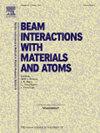Development of 12C-enriched irradiation-resistant diamond targets for astrophysical 12C(α,γ)16O reaction measurements
IF 1.4
3区 物理与天体物理
Q3 INSTRUMENTS & INSTRUMENTATION
Nuclear Instruments & Methods in Physics Research Section B-beam Interactions With Materials and Atoms
Pub Date : 2025-05-30
DOI:10.1016/j.nimb.2025.165742
引用次数: 0
Abstract
The 12 16 reaction plays a pivotal role in nuclear astrophysics research. The direct measurement of this reaction remains particularly challenging due to its extremely low cross section (approximately barn at 300 keV) within the Gamow window. This study addresses the critical need for irradiation-resistant 12-enriched targets to enable accurate measurements. We successfully fabricated a 12-enriched diamond target on molybdenum substrate through Microwave Plasma Chemical Vapor Deposition (MPCVD), demonstrating remarkable stability under high-intensity proton beam irradiation. Experimental results revealed only a 1.8% decrease in the 12 13 reaction yield in the 12 layer following proton bombardment at 270 keV with 2 mA beam current and a total accumulated charge of 124.2 C, indicating a significant improvement compared to conventional carbon targets. Isotopic analysis confirmed a 13/12 ratio of , verifying the absence of contamination during MPCVD processing. Additionally, we developed a novel nuclear-reaction-based methodology for quantifying hydrogen content in thin films, establishing an upper limit of 0.058% (95% confidence level) for hydrogen concentration in the diamond target. The combined irradiation resistance and isotopic purity of this target meet the stringent requirements for direct 12 16 reaction measurements in astrophysical environments.
用于天体物理12C(α,γ)16O反应测量的富12C抗辐照金刚石靶的研制
12C (α,γ)16O反应在核天体物理研究中起着举足轻重的作用。由于该反应在伽莫夫窗口内的横截面极低(在300 keV时约为10 - 17 barn),因此直接测量该反应仍然特别具有挑战性。这项研究解决了对抗辐照12c富集靶标的迫切需求,以实现准确的测量。利用微波等离子体化学气相沉积(MPCVD)技术在钼基体上成功制备了富含12c的金刚石靶材,该靶材在高强度质子束照射下具有良好的稳定性。实验结果表明,在270 keV、2 mA束流和124.2 C的总累积电荷下,质子轰击12C层12C (p,γ)13N反应产率仅下降1.8%,与传统碳靶相比有显著改善。同位素分析证实13C/12C比值为(9.7±1.3)×10−5,证实在MPCVD处理过程中没有污染。此外,我们开发了一种新的基于核反应的方法来定量薄膜中的氢含量,建立了金刚石靶中氢浓度的上限为0.058%(95%置信水平)。该靶品的耐辐照性和同位素纯度均满足天体物理环境下12C (α,γ)16O直接反应测量的严格要求。
本文章由计算机程序翻译,如有差异,请以英文原文为准。
求助全文
约1分钟内获得全文
求助全文
来源期刊
CiteScore
2.80
自引率
7.70%
发文量
231
审稿时长
1.9 months
期刊介绍:
Section B of Nuclear Instruments and Methods in Physics Research covers all aspects of the interaction of energetic beams with atoms, molecules and aggregate forms of matter. This includes ion beam analysis and ion beam modification of materials as well as basic data of importance for these studies. Topics of general interest include: atomic collisions in solids, particle channelling, all aspects of collision cascades, the modification of materials by energetic beams, ion implantation, irradiation - induced changes in materials, the physics and chemistry of beam interactions and the analysis of materials by all forms of energetic radiation. Modification by ion, laser and electron beams for the study of electronic materials, metals, ceramics, insulators, polymers and other important and new materials systems are included. Related studies, such as the application of ion beam analysis to biological, archaeological and geological samples as well as applications to solve problems in planetary science are also welcome. Energetic beams of interest include atomic and molecular ions, neutrons, positrons and muons, plasmas directed at surfaces, electron and photon beams, including laser treated surfaces and studies of solids by photon radiation from rotating anodes, synchrotrons, etc. In addition, the interaction between various forms of radiation and radiation-induced deposition processes are relevant.

 求助内容:
求助内容: 应助结果提醒方式:
应助结果提醒方式:


